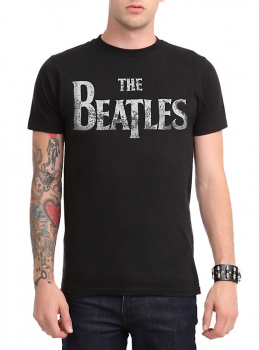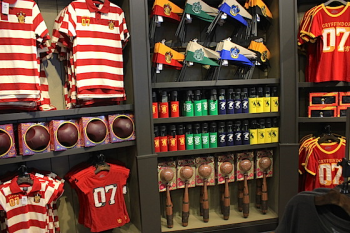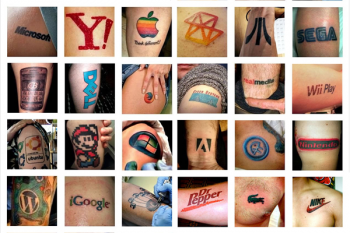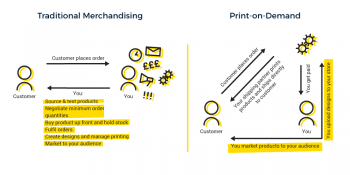
‘Love’ is a strong word. Particularly when it’s being used to describe the way we feel about brands.
But, in today’s ultra-competitive world of business, it’s clear: the most successful brands are the ones who come closest to establishing that intense kind of relationship.
In this article, I’ll talk a little more about creating brands that resonate emotionally with consumers. AND I’ll introduce a tech tool/business model that I believe can play a key role in taking your brand just a little bit closer to that level – with minimal setup work and next-to-zero up-front cost.
From brands to ‘Lovemarks’
I’ve been thinking a lot lately about the importance of loyalty for modern brands; what makes (and breaks) it, and how loyalty actually looks. I think the best illustration I’ve come across is Saatchi & Saatchi’s ‘Lovemarks’ model, defined quite literally as ‘Loyalty Beyond Reason.’

A ‘Lovemark’ can be a celebrity, a building, a song, a service or product – but, either way, it’s something that creates a strong emotional connection and a sense of belonging. These are properties and products so powerfully put together that they shape the very identity of consumers who experience them. Think the Beatles, IKEA, Apple and Harry Potter – it isn’t enough to ‘like’ them. They create visceral, lifelong connections. We forget that they’re corporate identities and relate to them on a deeply personal level. And, as you can see from the Lovemarks list, being a ‘Lovemark’ isn’t solely the reserve of big business and billion-dollar brands. There are plenty of startups and SMB’s that fit the profile, too.
It’s a combination of love and respect. In the words of Saatchi & Saatchi, “Brands’ might be respected but lack the strong emotional resonance that draws people to love them. Fads might be loved for a short period of time, but they lack consumers’ respect. When a product enjoys neither respect nor love, it is merely a commodity.” Combining both ‘love’ and ‘respect’ is where Lovemarks are created. And, while I’m not saying it’s easy – I also believe that anyone can do it with the right brand, the right audience and the right message.
Merchandise = Love?
Respect, quite simply, is built through brilliant basics. The quality (and ethics/shared values) of your product or service; a commitment to not letting your customers down; and delivering on your promises.
But ‘love’ is an altogether different emotion. According to Oath’s Brand Love Index, there are six drivers of brand love – brands can be judged by how well they’re able to exceed needs, set trends, share values, build trust, elevate experiences, and respect consumers.
When I think about some of the uniting factors shared by the ‘Lovemarks’ I mentioned earlier, a couple of things stand out. One is that they all conform pretty closely to the six factors above. And the other is that they often do this by delivering ‘physical pieces’ of their brand for consumers to own.
Whether it’s t-shirts, coffee cups, commodities, or living, breathing theme parks, they all have inherent cool factor. And while the individual wearing it may not be fully conscious of it, they’re all symbols of brand evangelism. People buy, wear and use these items because they love those brands, and by wearing them, that relationship deepens even further. They feel part of a movement, something bigger than themselves – fulfilling the inherent human desire to form ‘tribes’ – something that often happens around the most niche and obscure of things.


(Beatles image: HotTopic)
(Harry Potter image: Theme Park Insider)
It’s the same ideology that drives people to immortalise brands and logos on their bodies via permanent tattoos. These brands and their values matter so deeply to these people that they’ll spend the rest of their lives walking around with that logo on their body.

(Image: Nonbox.com)
To have and to hold
Creating a merchandise range is a great way to commodify your brand – sharing values, setting trends and elevating experiences, just as Oath’s index outlines. It gives your customers something, quite literally, to have and hold – a piece of your brand that is, in a very real way, part of their lives that transcends your physical product.
But, for years, merchandising has been regarded as something difficult and risky to implement. You have to take your focus off your core product offering to setup this new arm of your business; you have to invest and hope that you turn a profit.
Print-on-demand merchandising changes that, removing many of the barriers to entry and completely removing the issue of up-front cost.
In simple terms, print-on-demand involves merchandise products being printed only when they’re ordered and paid for by your customers. It means no minimum order quantities, no supplier negotiation, and no logistical headaches around order fulfilment. You just upload your designs – ‘set it and forget it’ – and whenever a customer places an order, it’s fulfilled by your print-on-demand partner. If it doesn’t sell, no big deal. If it does sell – you make passive income. Not too shabby.
More than this – when successful – you’re creating an army of brand advocates, walking around as part of your ‘movement’ with your brand emblazoned proudly on the things they wear and use.

Growing your brand and sales
This all makes print-on-demand a bit of a ‘no brainer.’ Of course – full disclosure – merchandise alone isn’t going to turn your brand into a Lovemark. But it’s a healthy step in the right direction. And because it’s so easy to setup, with so few ongoing headaches – the question is: can you afford not to?



